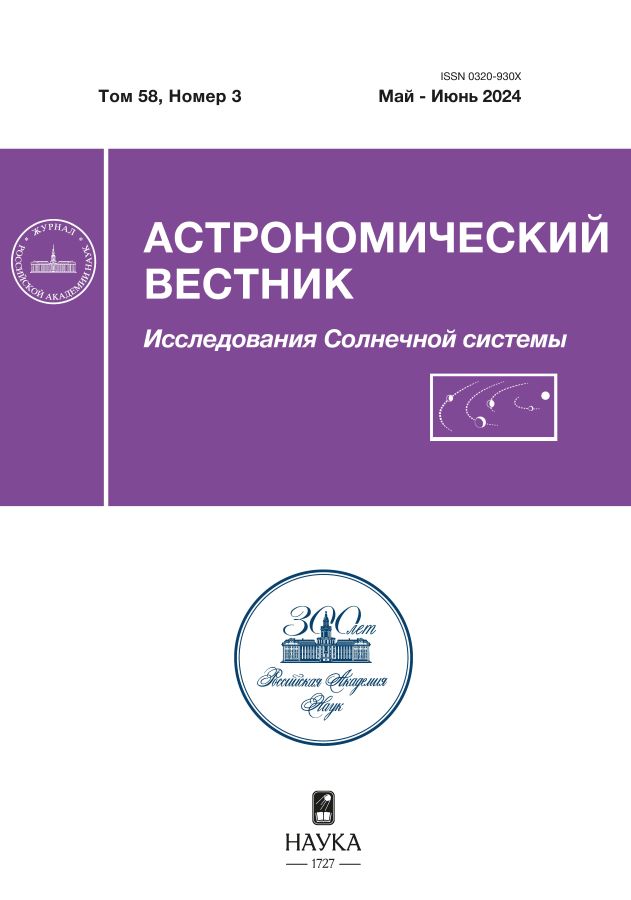Gaia Data Release 3: распределение спектральных групп астероидов, сближающихся с Землей
- Authors: Щербина М.П.1,2, Ковалёва Д.А.1, Шустов Б.М.1
-
Affiliations:
- Институт астрономии РАН (ИНАСАН)
- МГУ им. М.В. Ломоносова, Астрономический ин-т им. П.К. Штернберга (ГАИШ МГУ)
- Issue: Vol 58, No 3 (2024)
- Pages: 363-370
- Section: Articles
- URL: https://ter-arkhiv.ru/0320-930X/article/view/648558
- DOI: https://doi.org/10.31857/S0320930X24030098
- EDN: https://elibrary.ru/NDWYQV
- ID: 648558
Cite item
Abstract
На основе данных третьего выпуска каталога КА Gaia, содержащих спектры отражения астероидов, были проведены исследования астероидов, сближающихся с Землей (АСЗ). Спектры отражения около 100 представителей групп Атона, Аполлона и Амура были использованы для определения их спектрального класса. Для 47 астероидов такая оценка была сделана впервые. Для удобства классы были сгруппированы в более широкие спектральные группы (по Толену). Распределение по спектральным группам (в среднем 60% S-группа, 20% C-группа, 20% другие) соответствует результатам, полученным ранее с использованием других данных по большей выборке объектов. Такое распределение остается похожим на то, что известно для АСЗ разных размеров. Несмотря на численное преобладание в выборке АСЗ астероидов группы S, астероиды примитивных типов (группы С) обнаруживаются и на очень малых перигелийных расстояниях, что косвенно может подтверждать массовость явления сублимационной активности астероидов.
Full Text
About the authors
М. П. Щербина
Институт астрономии РАН (ИНАСАН); МГУ им. М.В. Ломоносова, Астрономический ин-т им. П.К. Штернберга (ГАИШ МГУ)
Author for correspondence.
Email: mpshcherbina@inasan.ru
Russian Federation, Москва; Москва
Д. А. Ковалёва
Институт астрономии РАН (ИНАСАН)
Email: mpshcherbina@inasan.ru
Russian Federation, Москва
Б. М. Шустов
Институт астрономии РАН (ИНАСАН)
Email: mpshcherbina@inasan.ru
Russian Federation, Москва
References
- Савелова А.А., Бусарев В.В., Щербина М.П., Барабанов С.И. Использование шаблонов спектральных типов астероидов для уточнения минералогии этих тел и обнаружения признаков сублимационно-пылевой и солнечной активности // Научн. труды Института астрономии РАН. 2022. Т. 7. С. 143–148.
- Шустов Б.М. О роли науки в изучении и парировании космических угроз // Вестн. Российск. акад. наук. 2019. Т. 89. № 8. С. 777–799.
- Щербина М.П., Бусарев В.В., Барабанов С.И. Спектрофотометрия астероидов в 2016 г. и интерпретация их спектров отражения // Экологич. вестн. научн. центров Черноморского экономического сотрудничества (ЧЭС). 2017. Т. 2. № 4. С. 148–156.
- Щербина М.П., Бусарев В.В., Барабанов С.И. Спектрофотометрические исследования астероидов, сближающихся с Землей, и Главного пояса // Вестн. Московск. университета. Сер. 3: Физика, астрономия. 2019. № 6. С. 93–96.
- Binzel R.P., DeMeo F., Turtelboom E.V., Bus S.J., Tokunaga A., Burbine T.H., Lantz C., Polishook D., Carry B., Morbideli A., and 13 co-authors. Compositional distributions and evolutionary processes for the near-Earth object population: Results from the MIT-Hawaii Near Earth Object Spectroscopic Survey (MITHNEOS) // Icarus. 2019. V. 324. P. 41–76.
- Bus S.J., Binzel R.P. Phase II of the small Main-Belt asteroid spectroscopic survey: A feature-based taxonomy // Icarus. 2002. V. 158. № 1. P. 146–177.
- Busarev V.V., Savelova A.A., Shcherbina M.P., Barabanov S.I. Spectral signs of simultaneous sublimation activity and the appearance of a dust exosphere on eight asteroids of the Main Belt near perihelion // Sol. Syst. Res. 2022. V. 56. № 2. P. 84–99.
- Busarev V.V., Petrova E.V., Shcherbina M.P., Kuznetsov S.Y., Burlak M.A., Ikonnikova N.P., Savelova A.A., Belinski A.A. Search for signs of sublimation-driven dust activity of primitive-type asteroids near perihelion // Sol. Syst. Res. 2023. V. 57. № 5. P. 449–466.
- Fujiwara A., Kawaguchi J., Yeomans D.K., Abe M., Mukai T., Okada T., Saito J., Yano H., Yoshikawa M., Scheeres D.J., and 12 co-authors. The rubble-pile asteroid Itokawa as observed by Hayabusa // Science. 2006. V. 312. № 5778. P. 1330–1334.
- Gaia Collaboration. Gaia Data Release 3-Summary of the content and survey properties // Astron. and Astrophys. 2023. V. 674. id. A1 (22 p.).
- Grav T., Mainzer A.K., Bauer J.M., Masiero J.R., Stevenson R., Carolyn N., and NEOWISE Team. The WISE survey of the near-Earth asteroids (NEOWISE) // Am. Astron. Soc. Meeting Abstracts. 2013. V. 222, id.402.01.
- Hein A.M., Saidani M., Tollu H. Exploring potential environmental benefits of asteroid mining //arXiv preprint arXiv:1810.04749. 2018.
- Mainzer A., Grav T., Masiero J., Bauer J., Cutri R.M., McMillan R.S., Wright E.L. Physical parameters of asteroids estimated from the WISE3-band data and NEOWISE post-cryogenic survey // Astrophys. J. Lett. 2012. V. 760. № 1. L. 12.
- Masiero J.R., Grav T., Mainzer A.K., Nugent C.R., Bauer J.M., Stevenson R., Sonnett S. Main-belt asteroids with WISE/NEOWISE: Near-infrared albedos // Astrophys. J. 2014. V. 791. № 2. P. 121.
- McMahon J.W., Scheeres D.J., Hesar S.G., Farnocchia D., Chesley S., Lauretta D. The OSIRIS-REx radio science experiment at Bennu // Space Sci. Rev. 2018. V. 214. P. 1–41.
- National Research Council (NRC) Defending Planet Earth: Near-Earth-Object Surveys and Hazard Mitigation Strategies // Washington, DC: The National Academies Press. 2010. – 134 p.
Supplementary files

















